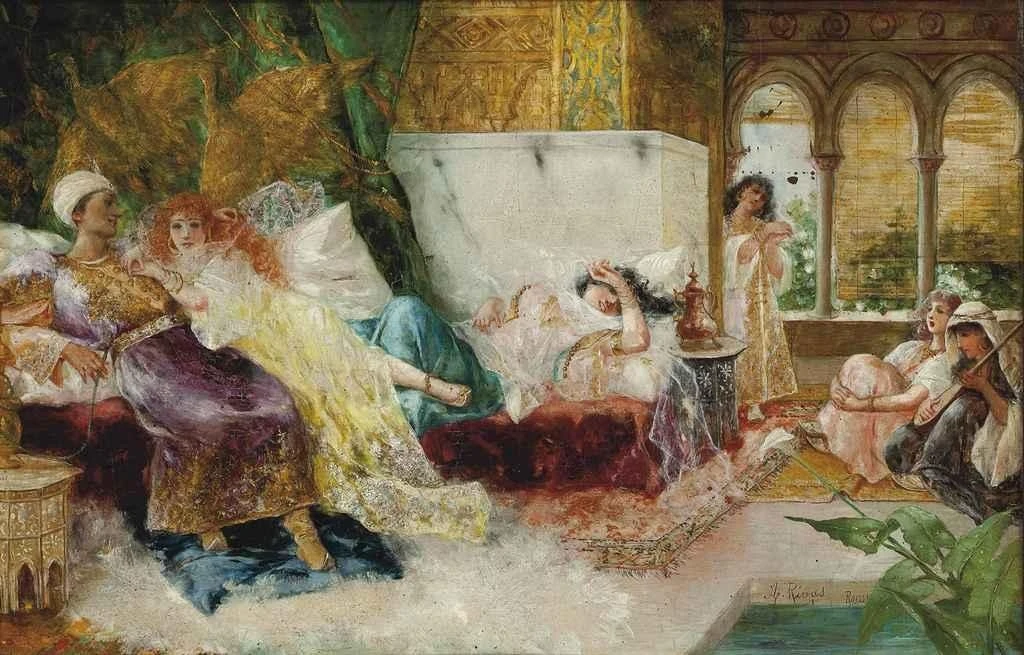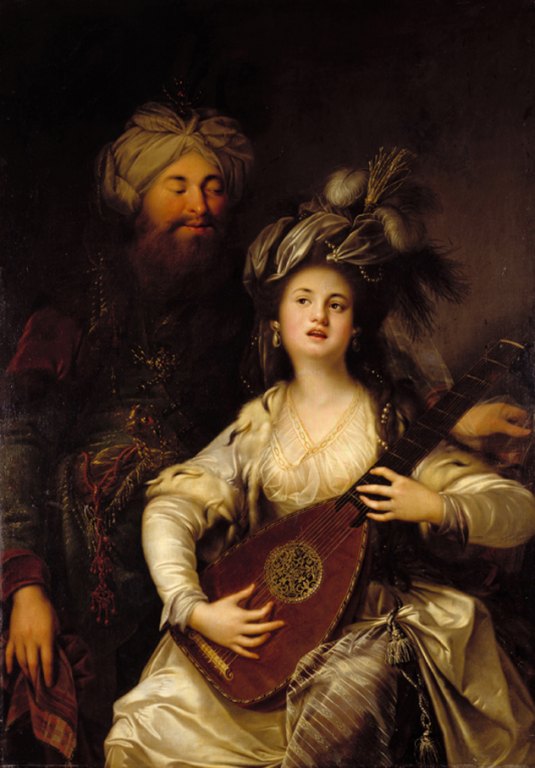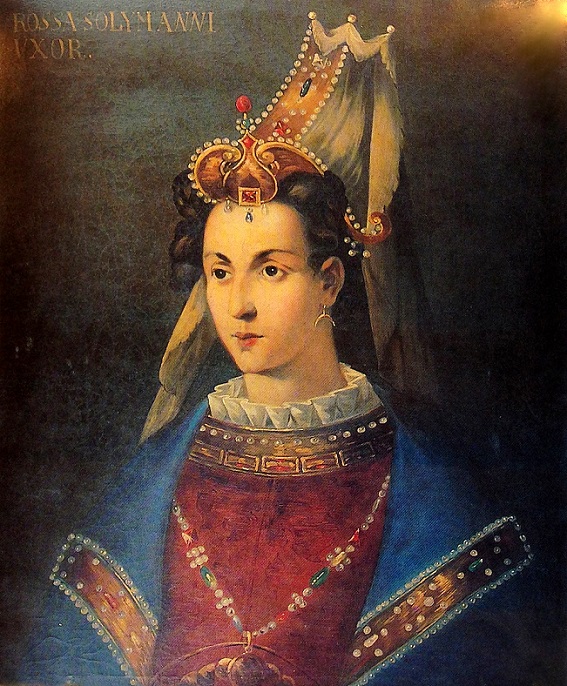For this first edition of Your Sexual History, I thought it would be fitting to write about the world’s most famous redheaded sex worker: Hürrem Sultan, a member of Suleiman the Magnificent’s harem who, defying hundreds of years of tradition, became his sole sexual partner and then his wife. Her move from slave to sultana (a title created specifically for her by Suleiman) embodies the complexities of sex work and of the Ottoman Empire that are absent from mainstream Western discourse about either subject.

Hürrem is also known as Roxelana, which means “The Maid from Ruthenia.” Ruthenia is located in what is now Ukraine, a region that was a near-constant target for Crimean Tatar and Turkish slave raids. It’s estimated that, between the fifteenth and early seventeenth centuries, about 2.5 million Ruses, Poles, and Ukrainians were abducted and sold into bondage in the Ottoman Empire. While Ottoman slavery (as in other parts of the Muslim world) was quite different from chattel slavery in the Americas, as there was the possibility, not guarantee, of gaining freedom and great prestige. Regardless of how high they climbed, slaves were always stripped of their original identities, deracinated and forcibly converted to Islam. As such, Hürrem’s real name (likely Anastasia or Aleksandra) and exact birthdate (sometime between 1502 and 1506) are lost to history.
This lack of hard evidence about her life only slightly improves during her time in the imperial court. All visual representations of Hürrem/Roxelana were created by artists exclusively working from descriptions of her. Despite the unique and prominent position she held, the best records are from European visitors who repeated things they’d heard or glimpsed and then projected their own prejudices upon. Writing too much about another guy’s wife, especially the sultan’s, was frowned upon by the Ottomans, which is why native sources not penned by Suleiman or Hürrem (such as this) are largely about operational matters. While these official documents do tell a love story—land grants from Suleiman to Hürrem were written with expensive inks made of gold leaf and lapis lazuli rather than the regular stuff—more specifics can be gleaned from accounts generated by horned-up, unreliable narrators like Genoese traders and Venetian diplomats.
Two Truths and a Lie: The Harem

The harem is perhaps the greatest example of how exaggerated contemporaneous written and pictorial accounts by Europeans can get. Rather than a giant sex dungeon where, between lengthy fuck-sessions with the sultan, soapy babes lazily floated in pools and doe-eyed beauties in Bedouin headdresses diddled each other on big pillows, the harem was a highly structured unit with a strict hierarchy and rules. More importantly, it played an integral role in the empire and its continued existence. Nearly every Ottoman ruler was descended from the union of a concubine and the ruling sultan. When your empire is this big, you don’t really need to marry to create alliances. Slaves, unlike wives, had no rights over their children under Islamic law, which made a harem the optimal place to create contenders for the throne. (This was more than a triumph of “fathers’ rights”—more on this system later.)
To assure the quality of the sultan’s experience inside this incredible space that was strictly reserved for him (and his heirs), the harem functioned as the only Ottoman university for women: slave girls (primarily Slavs taken from the Caucuses, areas that were on the edges of the empire) were taught how to read and write, play instruments, dance, court etiquette, embroidery, and about Islam. Throughout the ages, the vast majority of the women who lived in the harem did not have sex with the sultan; there were between 130 and 600 women living there over the harem’s various incarnations, and sultans for the most part did not indiscriminately “taste the rainbow.” The valide sultan, the sultan’s mother, oversaw the harem and chose women in the harem for him to have sex with. (Yes, it was official Ottoman policy for the sultan’s mommy to pick his girlfriends.) There were also midwives (highly regarded) and servants to the other women in the harem (bottom of the pecking order) in addition to women who had fun titles like Mistress of the Coffee, Mistress of the Sherberts, Mistress of the Laundry, or Keeper of the Jewels. Still, all harem members were all taught the art of love [Venetian horniness intensifies] in case they spent the night with the sultan, but they were also taught about birth control (they used barrier methods!) and sexual health. For girls who’d grown up in conditions that are difficult to imagine—subject to famine, malnutrition, poverty, pandemics, hard labor, and freezing temperatures (among other hardships)—becoming a concubine was an incredible opportunity. An opportunity, not guarantee: you could get stuck doing some mean girl’s laundry and not have time to enjoy the illustrated manuscripts and artisanal sherberts.
Hürrem’s Not-So Excellent Adventure
In my experience, I’ve found that seizing an opportunity invariably involves hard work and luck, though the exact ratio of each varies greatly. Hürrem’s success in the microcosm of the harem and then the court drew ire from the janissaries and members of the public—she was called a Russian witch—but from what can be gleaned from the historical record, I maintain she fucking earned it. Hürrem was marched from her home to the Black Sea (over 900 miles/1450 kilometers), then taken by boat to the slave market in Constantinople. She was likely given to Suleiman the Magnificent, the tenth Ottoman sultan, as a present. Physical descriptions of her state that she was no great beauty (or maybe just compared to the Armenian baddies that she was surrounded by), but the name she was given points to what differentiated her from all the others: Hürrem means “joyful” or “the laughing one” in Persian. (Like the Mughals, Persian was the language of the Ottoman court and literature.) As is true today, being a successful sex worker isn’t just about beauty, it’s also about being fun to spend time with. Hot, boring people don’t satisfy in the long run.

One legend has it that Suleiman overheard Hürrem singing a song in her native tongue as she was doing laundry and began speaking to her in fluent Ukrainian/Russian. From there, their love blossomed. Suleiman forsook all other concubines and, defying tradition, continued his relationship with Hürrem after she had a son. The couple would go on to have four more sons and several daughters. His monogamy dismayed the public and his mother Hafsa Sultan. The Ottomans had continued the Seljuk policy of one concubine mother, one royal son. A prince’s mother was meant to be his greatest adviser, and, when he came of age, she would accompany him to the provinces at age sixteen or seventeen so he could learn how to rule. Like the Mongols (who also influenced the contours of Ottoman society), these post-sexual women were among the most powerful people in the realm. Yet, because she was a slave, these princes’ mothers would have no rights over him, and be tied to his service. Every society, including ours, has glaring contradictions. The role of these women is one of the trickiest in the Ottoman system.
However, Hürrem was blowing this open. Having more than one son split the mother’s focus, which meant weaker heirs for the sultan to choose from. All princes inherited equally—there was no primogeniture—and the sultan chose his successor from the wealth of candidates he had thanks to his harem. This saved the empire from being stuck with a lousy first son, but also posed the threat of splitting up the empire. The Ottomans dealt with this abundant selection of heirs by allowing the sultan’s pick to kill his brothers. More commonly, the most adept son would murder the others, leaving the father one choice. Fratricide was allowed in order to maintain stability and insure the best leadership. Having a few brothers die instead of thousands in some war of succession is better, but the optics are terrible.
Thus, having multiple eligible heirs with the same woman disrupted this system: Hürrem was equally aligned with all of her sons. She bucked tradition and stayed in the capital when they were sent away to learn statecraft. This allowed her to inform Suleiman of what was happening at court while he was away on military campaigns, granting her even greater importance to his rule. She guarded his interests and implemented his will while he wasn’t physically present—again, a role typically played by the sultan’s mother. After a fire in Eskisarai, the Old Palace (where the harem was located), Hürrem became the first woman to live at Topkapi Palace, the symbolic core of imperial power. Mehmed the Conqueror, who took Constantinople from the Byzantines, had decreed that no women could set foot inside Topkapi—and yet, there she was. The harem went with her, securing its place of power alongside her.
Hürrem’s actions disrupted 300 years of other traditions too. The sultan’s mother was no longer his best adviser and the most powerful woman in his court. Hafsa Sultan tried to wrest control of Suleiman back by purchasing two redheaded Russian slaves who looked like Hürrem, but she was unsuccessful in ending her son’s monogamy. After Hafsa Sultan’s death in 1534, Suleiman freed Hürrem and then married her in a grand public ceremony. The other concubines in the harem, all virgins, were married off to Suleiman’s courtiers—men who had also been taken as slaves and trained at the palace for imperial service. (I’m sure these newlyweds had a lot to talk about.) Her ascension to sultana—and the fact Ottoman women, even royal ones, were not meant to be seen—caused enormous controversy.
Hürrem’s Big Promotion
As sultana, Hürrem’s influence grew and she forged an entirely new role for herself. She corresponded with foreign dignitaries, most notably Catherine di Medici and the Polish kings Sigismund the Old and Sigismund Augustus. The Ottomans forged an alliance—twice!—with the Kingdom of Poland, a rare partnership between Muslim and Christian rulers. Slave raids in the kingdom ended at Hürrem’s request, and many Polish captives were returned home—her native Ruthenia was a part of Poland. However, it’s hard to state with confidence her impact on other aspects of international or domestic policy: what happens in the corridors of power tends to stay there. People of the era, Ottoman and European alike, tended to ascribe Sueliman’s wildly unpopular decisions to Hürrem, such as the assassination of his first son, Mustafa. Mustafa, whose mother was his favorite before Hürrem, was beloved by the military and was considered to be the shoe-in for Suleiman’s successor. The official reason given for Mustafa’s murder (performed by three mutes in a tent) was an alleged plot to depose his father. Again, it would seem that Hürrem (and her sons) would have the most to gain from this, but other members of court (including shifty characters like a geomancer) could’ve influenced, if not outright dictated, Suleiman’s decision. (Well-developed backchannels tend to remain secret; if you do hear about them, that means somebody fucked up.) Though there wasn’t a constant turnover, Suleiman wasn’t shy about removing members of his court who approached or threatened to eclipse his power. Grand Vizier Ibrahim Pasha, who could be described as Suleiman’s other great love, was garotted and his corpse was left in Topkapi’s courtyard after he became a bit too vainglorious. Was his fate also attributed to Hürrem’s machinations? Of course. It didn’t matter that Ibrahim bragged that he could make anything in the empire happen and led military campaigns without his sultan, which were two very good reasons for him to be done away with. But did Hürrem actually do it? We can’t rule it out.

Although she was a profoundly disruptive character that upset and confounded those within and outside of her realm, Hürrem cared deeply about public sentiment. She embarked on a staggering number of building projects. The first was the Avrat Pazar (women’s market) in Constantinople, not far from the slave market where she had been sold. Inside this complex were a mosque, a madrasa, a soup kitchen, an elementary school, a hospital, and a fountain—in short, a place for poor women to have their physical and spiritual needs tended to. No expense was spared, as these facilities were designed by Mimar Sinan, the court’s architect. (Sinan also designed the Süleymaniye Mosque and ensured that the Hagia Sofia remained structurally sound; if you go to the extremely crappy Hagia Sofia Museum, he’s portrayed as the site’s great hero.) Hürrem commissioned many soup kitchens, mosques, bath houses, and infrastructure projects around the empire, particularly along the route to Mecca in order to aid pilgrims undertaking the hajj. These glorious buildings remain standing, manifestations of her life before, during, and after enslavement.
Hürrem died in 1558, eight years before Suleiman, and was buried in a private structure behind the grand mosque he had commissioned. Unlike other sultanas, she wasn’t buried next to her husband, likely because she died before he did. (Her son Selim II and her granddaughter Hatice Sultan are also inside her ornate tomb.) She remained singular into death and beyond.
Hürrem redefined the role of women in the Ottoman court, and she was emulated by the harem favorites who followed her. She inaugurated what is known as “the Sultanate of Women,” which lasted from her reign until 1683. (I may return to this period of history for another entry.) These women not only exerted similar power over the empire that Hürrem did, but also gifted Istanbul with some of its greatest architecture. There’s much more to be said about this controversial historical figure—I didn’t even touch Magnificent Century, the Turkish soap opera that dramatizes Hürrem’s life. (I haven’t seen all 600-or-so episodes of the show, but it doesn’t shy away from depicting Hürrem as an opportunist at certain points in her life.) However she exerted control, an inextricable part of Hürrem’s story is more than a real-life Pretty Woman. This is not a sex worker who was “saved” by a gallant, wealthy man, but a sex worker who did a fair amount of saving herself. I’ll leave you with a few verses from “Marusia of Bohuslav,” a Ukrainian folk song about the daughter of an Orthodox priest who’s sent to a pasha’s harem. After feeling conflicted about the “Turkish luxury” that she enjoys, Marusia chooses to liberate 700 of her countrymen on a Holy Saturday:
Thus on the Day of the Resurrection
The Turkish lord sought the mosque’s arcade
But into the hand of the captive maid
The keys of the dungeon dark he laid.
Then the captive maid was true
To the deed she had promised to do;
To the dungeon walls she came
And unlocked the door of the same;
Thus with the pasha’s key
She set the captives free.
Leave a Reply